
Jonathan Trent Keynotes
As NASA's lead scientist on the perfection of microalgae as an energy source, Jonathan Trent's...

Need Inspiration?
Get inspired by 4,000+ keynote speaker videos & our founder, a top keynote speaker on innovation.
Jonathan Trent’s New Energy Sources Keynote
Elise Ying-Hei Ho — December 5, 2012 — Keynote Trends
Scientist Jonathan Trent talks about the importance of growing natural energy sources by resourcefully reusing what is already available in his new energy sources keynote.
Approximately 100 times the energy that soy beans can provide, microalgae can contribute to approximately 2,000 to 5,000 gallons per acre per year in energy, which can produce the equivalent of approximately two million gallons of fuel. These organisms are extremely small and are one of the fastest growing plants, making them ideal for an energy source. Trent’s idea includes using the method OMEGA, Offshore Membrane Enclosures for Growing Algae, which uses clean wastewater as well as carbon dioxide to produce bio-fuels using microalgae.
Trent is constantly trying to perfect the OMEGA system and in the process, considers various things that may affect the final outcome of the new energy source, not only scientifically but realistically as well. Aside from biological concerns, his team has taken into account engineering—building the system on a small versus large scale—environmental impact as well as cost efficiency.
Approximately 100 times the energy that soy beans can provide, microalgae can contribute to approximately 2,000 to 5,000 gallons per acre per year in energy, which can produce the equivalent of approximately two million gallons of fuel. These organisms are extremely small and are one of the fastest growing plants, making them ideal for an energy source. Trent’s idea includes using the method OMEGA, Offshore Membrane Enclosures for Growing Algae, which uses clean wastewater as well as carbon dioxide to produce bio-fuels using microalgae.
Trent is constantly trying to perfect the OMEGA system and in the process, considers various things that may affect the final outcome of the new energy source, not only scientifically but realistically as well. Aside from biological concerns, his team has taken into account engineering—building the system on a small versus large scale—environmental impact as well as cost efficiency.
1.3
Score
Popularity
Activity
Freshness
















